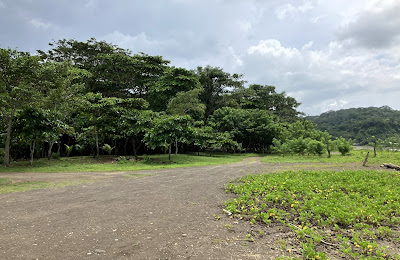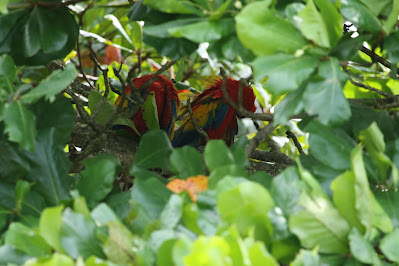 |
Although widely distributed across the Amazon basin, Venezuela and Colombia, Scarlet Macaws have a more patchy presence in Central America. They are classed as being of 'least concern' in global conservation terms, but their numbers are declining nevertheless and the IUCN suggests that they are possibly extinct within areas of their former range in Mexico, Guatemala, Nicaraugua and Honduras. The last of these is potentially embarrassing, as they are the national bird. Capture for the pet trade remains a serious threat, as well as the more common problems of habitat loss and degradation. Within Costa Rica, my well-thumbed bird guide (Garrigues & Dean) highlights only three small areas of the country where they are likely to be found, all on the Pacific coast.
This was a worry. If the range of the species is so restricted, would we manage to track them down? But our guide Pat O'Donnell was quietly confident. And with good reason: they proved almost ridiculously easy to find. As I later discovered, Costa Rica is one of the best places in the Neotropics for Scarlet Macaw sightings - as the map of global records highlights (see GBIF).
 |
| Scarlet Macaw habitat - Beach Almond trees at Tarcoles |
The small seaside village of Tarcoles lies almost mid-way along the main road down Costa Rica's Pacific coast. The nearby Tarcoles River signals the boundary between two of the country's major habitat zones, the dry north Pacific lowlands and the more humid lands to the south. The road bridge over the river is also the best place in the country to spot American Crocodiles, but that's one for another blog post. Driving south across the river, Pat turned off the main road and headed for the beach (Playa de Tarcoles). We pulled up on a rough gravelled parking area (photo above) flanked by a grove of Beach Almonds Terminalia catappa. This tree is a non-native species from India. It might not be an actual almond, but it is hugely favoured by Scarlet Macaws.
We could hear their raucous calls as soon as we stepped out of the vehicle. A couple of birds flew north in a flash of colour, but the sounds were still coming so we set off to investigate. And there on the outside of the deep green foliage of a nearby tree I had my first proper sighting:
 |
| First sighting of a Scarlet Macaw - Tarcoles, Costa Rica |
For such a colourful bird, Scarlet Macaws can blend into the canopy of a Beach Almond tree surprisingly well. There turned out to be two birds in this tree, and they both kept moving. Getting a good view of them both needed some patience ...
 |
| Scarlet Macaws blending in |
... which finally paid off:
The two birds appeared to be a pair. At first sight, there is little obvious difference between male and female Scarlet Macaws, but these two stuck close together, paying each other plenty of attention in between detours to seek out the tree's fruits. There was much mutual preening - and more. It was difficult to tell whether they were trying to mate or having a fight - but then that's long standing relationships for you, I guess.
 |
| Scarlet Macaws getting friendly |
I found myself wondering why Scarlet Macaws are so insanely colourful; even within the notably gaudy parrot family the colour mix and brilliance of their plumage looks excessive. There are some useful pointers in a 2020 paper by Luisana Carballo and colleagues (see references below: link to paper here). This suggests that larger parrots living in warmer environments are the most colourful (Scarlet Macaws certainly tick both of those boxes), and that mutual mate choice and social selection may be more powerful evolutionary factors than maintaining crypsis (i.e. camouflage). Getting the right mate is particularly important in long-lived species that sustain a pair bond over many years, especially when resources are scarce, such as the larger cavities that these big birds need to nest in. Bright colours may be seen to signal a stronger and fitter individual, and as both males and females are both being choosy, both sexes are therefore vibrantly coloured. Or that's the theory, at any rate.
But it sounds like it's on the right lines. As shown in some of my photos, just because Scarlet Macaws are brightly coloured, it doesn't follow that they are always conspicuous. The red, yellow and blue combination can act to break up the macaw's overall shape (an idea called "disruptive colouration"), possibly confusing potential predators when several are in flight together. And perhaps counter-intuitively this colour pattern can also make the birds harder to make out within the canopy of an evergreen forest tree, which is a mix of light, shade and various colours as these photos show.
And as always, the science merely adds to the wonder of meeting one of the world's top birds - a true wildlife highlight on which to end this short blog series. (Although there will be more from Costa Rica to come, I think.)
References
BirdLife International (2022). Ara macao. The IUCN Red List of Threatened Species 2022: e.T22685563A163778999. [online] https://dx.doi.org/10.2305/IUCN.UK.2022-2.RLTS.T22685563A163778999.en.
Carballo, L., Delhey, K., Valcu, M. and Kempenaers, B. (2020). Body size and climate as predictors of plumage colouration and sexual dichromatism in parrots. Journal of Evolutionary Biology, 33(11), pp.1543-1557.



No comments:
Post a Comment